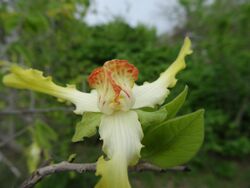Biology:Monodora grandidieri
| Monodora grandidieri | |
|---|---|

| |
| Scientific classification | |
| Kingdom: | Plantae |
| Clade: | Tracheophytes |
| Clade: | Angiosperms |
| Clade: | Magnoliids |
| Order: | Magnoliales |
| Family: | Annonaceae |
| Genus: | Monodora |
| Species: | M. grandidieri
|
| Binomial name | |
| Monodora grandidieri Baill.
| |
| Synonyms | |
|
Monodora somalensis Chiov. | |
Monodora grandidieri is a species of plant in the family Annonaceae. It is native to Kenya, Malawi, Mozambique, Somalia, and Tanzania.[2] Henri Ernest Baillon, the French botanist who first formally described the species, named it after the French naturalist and explorer Alfred Grandidier who collected the specimen Baillon examined.[3] It has been reported to be used as a traditional medicine by the Giriama and Digo people of Kenya.[4]
Description
It is a tree reaching 12 meters in height. Its branches have lenticels. Its leaves are 20–24 by 1.5–8.2 centimeters and come to a point at their tips. Its petioles are 2–3 millimeters long. Its flowers are solitary and appear before young leaves. Each flower is on a thin, lightly hairy pedicel 2–5.7 centimeters long. Its flowers have 3 sepals that are 1–2 by 3–5.5 centimeters with wavy, densely hairy margins. The sepals curve backwards and are green or red with green veins. Its 6 petals are arranged in two rows of 3. The outer petals are light yellow with green or red highlights, curve backwards, and come to a point at their tips. The outer petals are 3.7–6.5 by 0.5–1.8 centimeters, have wavy margins, and are densely hairy on their outer surface. The inner petals are similarly colored, have a 0.7–0.9 centimeter long claw at their base and a 1.2–1.6 centimeter wide blade. Its stamens are 1 millimeters long. Its smooth, green and white fruit are 5–7.5 by 4-4.5 centimeters in diameter. Its light brown seeds are 1.3–2.6 by 1-1.8 by 0.9–1.1 centimeters.[3][5]
Reproductive biology
The pollen of M. grandidieri is shed as permanent tetrads.[6]
References
- ↑ Cosiaux, A.; Couvreur, T.L.P.; Erkens, R.H.J. (2019). "Monodora grandidieri". IUCN Red List of Threatened Species 2019: e.T132683286A133046250. doi:10.2305/IUCN.UK.2019-3.RLTS.T132683286A133046250.en. https://www.iucnredlist.org/species/132683286/133046250. Retrieved 20 November 2021.
- ↑ "Monodora grandidieri Baill.". The Trustees of the Royal Botanic Gardens, Kew. n.d.. https://powo.science.kew.org/taxon/urn:lsid:ipni.org:names:74130-1.
- ↑ 3.0 3.1 Baillon, H. (1868). "Sur la Famille Des Anonacées" (in French, Latin). Adansonia 8: 295–344. https://www.biodiversitylibrary.org/item/10563.
- ↑ Pakia, M.; Cooke, J.A.; van Staden, J. (2003). "The ethnobotany of the Midzichenda tribes of the coastal forest areas in Kenya: 2. Medicinal plant uses". South African Journal of Botany 69 (3): 382–395. doi:10.1016/S0254-6299(15)30321-5. ISSN 0254-6299.
- ↑ Verdcourt, B. (1971). MONODORA grandidieri Baill. [family ANNONACEAE]. ITHAKA. https://plants.jstor.org/stable/10.5555/al.ap.flora.ftea002292. Retrieved April 9, 2019.
- ↑ Couvreur, Thomas L. P.; Botermans, Marleen; van Heuven, Bertie Joan; van der Ham, Raymond W. J. M. (2008). "Pollen morphology within the Monodora clade, a diverse group of five African Annonaceae genera". Grana 47 (3): 185–210. doi:10.1080/00173130802256913. ISSN 0017-3134.
Wikidata ☰ Q17140246 entry
 |


